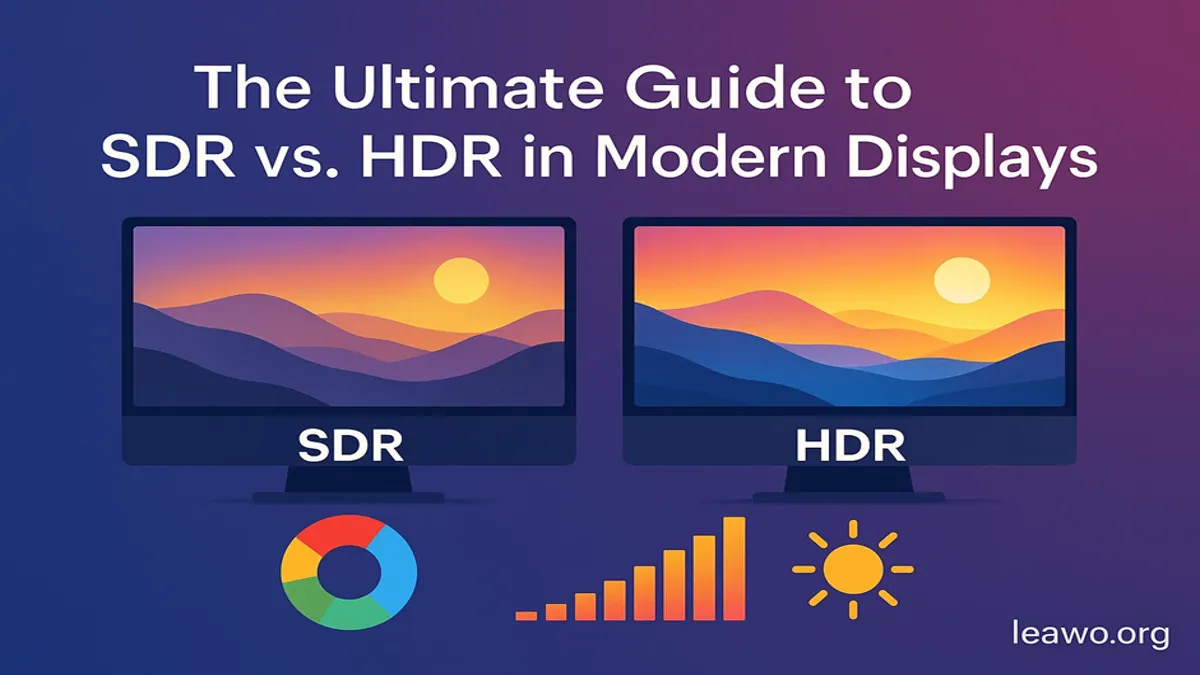As screen technology rapidly evolves, the debate of SDR vs HDR has become increasingly relevant to anyone watching content in high quality—whether it’s movies, gaming, or streaming on services like Netflix and Disney+. But what do these acronyms actually mean, and more importantly, SDR vs HDR, which is better for you?
In this guide, we’ll break down the SDR vs HDR meaning, provide a technical and visual comparison, and help you decide which format best suits your viewing habits—especially if you’re torn between 4K HDR vs 4K SDR.
Overview of SDR and HDR
To start, let’s clarify the SDR vs HDR meaning.
SDR (Standard Dynamic Range) is the traditional format used for most digital videos. It limits brightness, contrast, and color depth based on older display technologies, making it compatible with nearly all screens—even budget ones.
HDR (High Dynamic Range), on the other hand, is designed for modern displays that can handle more brightness, deeper contrast, and a broader color range. HDR improves image fidelity and brings out more detail, especially in dark shadows and bright highlights.
In modern content creation and streaming, HDR is becoming increasingly common—especially on platforms like Netflix, Apple TV+, and Disney+. However, SDR still remains the standard for many downloadable videos and budget streaming devices.
Technical Comparison: SDR vs. HDR
1 Brightness Levels
One of the most significant differences is brightness. SDR content typically caps brightness at 100-300 nits, while HDR content can exceed 1,000 nits or more on compatible displays. This makes HDR better at rendering lifelike highlights—like sunlight or reflections—without washing out the image.
2 Color Gamut
HDR supports a wider color gamut, particularly with color spaces like Rec. 2020 and DCI-P3, which allow it to display more vibrant and varied colors. SDR is generally limited to Rec. 709, which covers fewer hues and saturations.
3 Contrast Ratio
Contrast refers to the difference between the darkest black and brightest white. HDR enhances contrast dynamically, revealing more detail in shadows and highlights. SDR offers fixed contrast, making the image flatter by comparison.
4 Bit Depth
Bit depth affects how smoothly colors transition from one shade to another. SDR usually uses 8-bit color, which can display around 16.7 million colors. HDR uses 10-bit or more, allowing it to show over a billion colors, minimizing color banding and improving realism.
5 Dynamic Range
This is where HDR truly shines. Dynamic range is the span between the darkest and brightest elements in an image. SDR limits this range, while HDR offers a much broader spectrum, leading to more lifelike and immersive viewing experiences.
Viewing Experience: SDR vs. HDR
1 Visual Quality
There’s no denying HDR’s superior visual output. With higher brightness, deeper contrast, and richer colors, it offers an immersive viewing experience. Whether you’re watching a moody film noir or a vibrant animated movie, HDR can enhance the emotional and visual impact.
However, the benefits of HDR are only noticeable if your display supports it. Watching HDR content on an SDR screen may look no different—or worse—than traditional SDR.
2 Availability
SDR is still the industry standard for many downloaded and broadcast videos. It’s widely supported on older TVs, monitors, and streaming devices.
For example, if you’re someone who prefers to watch offline, many tools are available to download Netflix SDR videos for use on any device. This is a big advantage, as HDR content is often locked behind streaming-only features or premium subscriptions.
On the other hand, HDR content is increasingly found on:
- Netflix Premium plan
- Apple TV+
- Disney+
- Amazon Prime Video (select titles)
However, many of these services often provide you an option to stream HDR content in high-bandwidth conditions.
3 Device Compatibility
Not every device is HDR-ready. SDR works on virtually all TVs, smartphones, laptops, and projectors. HDR, however, needs a compatible screen (often labeled as HDR10, Dolby Vision, or HDR10+), as well as a fast internet connection for streaming.
If you’re using a device that doesn’t support HDR natively, watching HDR content may lead to reduced quality or color issues. This makes SDR the more universally compatible format for both streaming and offline viewing.
FAQs
Q1: Can I watch HDR content on an SDR screen?
Yes, but you won’t benefit from HDR enhancements. Most platforms will tone-map the content to match SDR capabilities.
Q2: Is there a way to watch HDR content offline?
Only a few platforms offer HDR downloads, and it’s usually limited to certain mobile apps or subscription tiers. If you’re looking for offline flexibility, it’s best to download Netflix SDR videos instead.
Q3: What tools can help me save Netflix SDR videos for offline viewing?
There are several options available. For a list of top tools, check out this guide to the best Netflix video downloaders.
Q4: Is 4K HDR always better than 4K SDR?
Not necessarily. While 4K HDR vs 4K SDR technically offers superior image quality, the difference may not be noticeable unless your screen is HDR-compatible and the content is properly mastered.
Conclusion: SDR vs HDR, Which is Better?
So, SDR vs HDR, which is better?
- If you’re a casual viewer, have older equipment, or rely on offline content, SDR is more than sufficient. It’s widely supported, and tools like those to download Netflix SDR videos make it even more convenient.
- If you’re chasing the best visual fidelity and own a high-end display, HDR is the way to go—especially for cinematic and immersive experiences.
Ultimately, the choice depends on your device setup, viewing habits, and content preferences. Both SDR and HDR have their strengths, and in today’s hybrid content world, understanding both formats helps you get the most out of your display.

